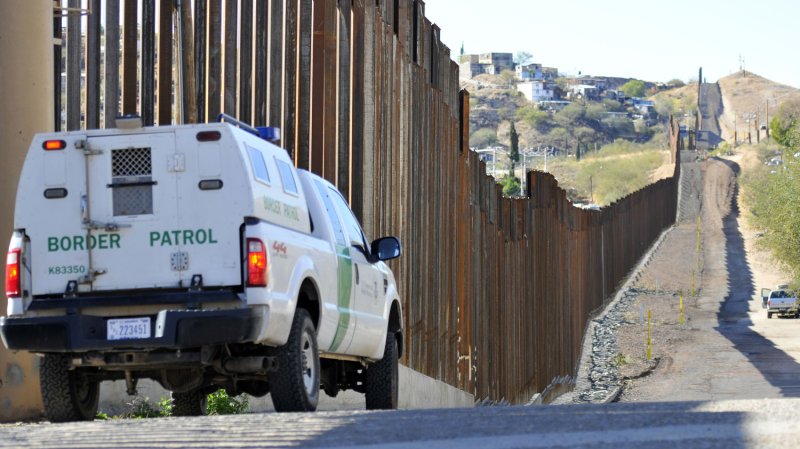1 of 2 | A Boarder Patrol truck sits along the boarder fence between the United States and Mexico. The "Fast and Furious" gun walking operation was first uncovered following the death of Border Patrol Agent Brian Terry who was gunned down by two men armed with at least two semi-automatics trafficked by "Fast and Furious" suspects. UPI /Art Foxall |
License Photo
The U.S. government's botched "Fast and Furious" gunwalking operation is leaving a deadly legacy in Mexico where weapons related to the operation regularly show up at crime scenes.
U.S. Sen. Charles Grassley said two guns linked to the operation were found last month after a gun battle between Sinaloa drug cartel members and the Mexican military.
Grassley said one of the weapons was lost by federal agents during "Fast and Furious" and the other was originally purchased by George Gillett, who served as Assistant Special Agent in Charge of the Bureau of Alcohol, Tobacco, Firearms and Explosives field office in Phoenix during the "Fast and Furious" scandal.
Grassley, who has asked Justice Department Inspector General Michael Horowitz to investigate the findings, said firearms records suggest Gillett was the purchaser of the weapon. He said it is one of three such records in Gillett's name that list a non-residential address.
"Using false home residences on Firearms Transaction Records is a felony," Grassley said.
The other weapon was an AK-47 purchased in Arizona by Uriel Patino, who allegedly bought 730 guns illegally under the watch of federal agents.
Gillett is still employed by the ATF, despite being recommended for disciplinary action. Grassley said a report by the inspector general called Gillett's supervision and judgment "seriously deficient."
"Fast and Furious" was an ATF operation based in Phoenix that allowed gunwalking, in which federal law enforcement agents allowed suspected criminals to buy weapons, with the hopes they would eventually lead them to Mexican drug leaders.
Some 2,000 weapons were lost under "Fast and Furious" and not one seizure was made, nor were any drug leaders arrested, officials said. The weapons are believed to still be moving back and forth across the U.S.-Mexican border and will likely show up at crime scenes for years, the Los Angeles Times reported.
The Justice Department, which initially denied knowledge of the gunwalking operation when it was first uncovered following the death of Border Patrol Agent Brian Terry, has since acknowledged major systemic problems with it.
"Fast and Furious" first came to light in January 2011 following the death of Terry, who was gunned down on Dec. 14, 2010, in Arizona by two men armed with at least two semi-automatics trafficked by "Fast and Furious" suspects. Several ATF agents contacted Grassley, who began investigating the case.
"Fast and Furious" has its roots in the "Project Gunrunner" initiative by the ATF in 2006, during the Bush administration, to stop drug and gun trafficking between Mexico and the United States.
Starting in 2009, ATF encouraged a select number of gun dealers in the Phoenix area to sell weapons to suspicious customers, some of whom would pay for their purchases with large sums of cash. Federal agents asked the gun dealers to contact ATF with names of the purchasers and the serial numbers of the weapons. The goal, ATF officials said, was to see where the guns landed in Mexico.
The Justice Department said the blame lay with officials in ATF's Phoenix office. Efforts to uncover the depth of the Justice Department's knowledge of the operation led to a U.S. House vote to hold Attorney General Eric H. Holder Jr. in contempt of Congress for withholding documents requested as part of a congressional investigation.
A report issued in October by the Oversight and Government Reform Committee, chaired by U.S. Rep. Darrell Issa, R-Calif., specifically found fault with five senior Justice Department officials for failing to identify red flags indicating reckless tactics. A number of ATF employees were also recommended for discipline. William McMahon, who was in charge of field operations, has been fired and going into the new year, other ATF managers are expected to lose their jobs.
Grassley, ranking member of the Senate Judiciary Committee, said Justice Department officials "saw any number of warnings and some even had the gunwalking information right in front of them, yet nothing was done to stop it."
Two years after his death, Terry's family has filed a wrongful death lawsuit against seven government employees, and a gun shop and its owner. McMahon and Gillett are among those named in the lawsuit.
Gary Grindler, Holder's chief of staff, announced in December he was leaving the Justice Department. Grindler's conduct was criticized by the inspector general in its review of "Fast and Furious."
"Gary Grindler was appropriately faulted by his Department's own inspector general for keeping information about a connection between the murder of a Border Patrol agent and a mishandled department operation away from the attorney general and the Department of Homeland Security," Issa said. "His departure from the Justice Department is warranted and long overdue."
Issa said other figures in "Fast and Furious" are currently being evaluated for their conduct.
"I expect more departures and discipline to come," he said.















